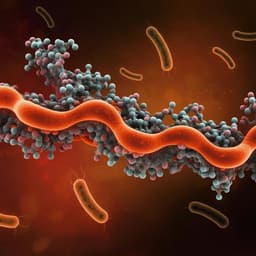
Engineering and Technology
Revealing nutritional requirements of MICP-relevant Sporosarcina pasteurii DSM33 for growth improvement in chemically defined and complex media
F. M. Lapierre, J. Schmid, et al.
Discover the groundbreaking research by Frédéric M. Lapierre and colleagues, harnessing microbial induced calcite precipitation (MICP) to boost the cultivation of Sporosarcina pasteurii. This study identifies key nutritional requirements, leading to a remarkable fivefold increase in biomass production, paving the way for innovative applications in biotechnology.
~3 min • Beginner • English
Introduction
Microbial induced calcite precipitation (MICP) has applications in soil reinforcement, remediation, CO2 sequestration and restoration of construction materials. Sporosarcina pasteurii is widely used for MICP due to high urease activity and suitability for alkaline, saline environments. Despite this, S. pasteurii is typically grown in complex media (e.g., yeast extract, peptone) that yield only moderate biomass (OD600 < 5), hindering economic feasibility of MICP at scale. Complex media also impede identification of growth-limiting or inhibitory components due to variable, undefined composition. Chemically defined media enable systematic identification of auxotrophies and nutritional requirements. Prior work reported varying auxotrophies among S. pasteurii strains and only one report of successful growth in a defined medium. This study aims to elucidate the nutritional requirements and auxotrophies of S. pasteurii DSM33 using high-throughput microplate cultivations in a chemically defined medium, identify effective carbon sources, translate findings to improve simple complex media, and characterize cultivation performance via oxygen transfer rate (OTR) and growth monitoring to enable higher-density, cost-effective cultivation for MICP.
Literature Review
The authors review that S. pasteurii is typically cultured in complex media (yeast extract or peptone), yielding modest biomass and variable results due to undefined composition. A chemically defined medium was previously used only to study ectoine biosynthesis with similar growth to complex media (Kuhlmann & Bremer, 2002). Reported auxotrophies for S. pasteurii strains include certain amino acids, thiamine, biotin, nicotinic acid, ammonia and glutamine, but requirements vary by strain. Complex media variability can affect growth rate, yield, and product quality, complicating optimization. Defined media allow straightforward identification of auxotrophies and nutritional needs and insight into metabolizable carbon sources. The study contextualizes MICP applications and the need for improved cultivation to enhance industrial feasibility.
Methodology
Strain and cultivation setup: Sporosarcina pasteurii DSM33 (DSMZ) was cryo-preserved in CaSo medium plus urea with 15% glycerol at −80 °C. Precultures were grown in chemically defined medium to OD600 ~0.05–0.1 inoculum, washed twice with PBS to avoid carryover.
Microplate cultivations (screening): BioLector I system with 48-well Flower Plates with DO optodes; culture conditions: 30 °C, shaking 1200 rpm, 3 mm orbit, 800 µL working volume, detector gain 20, humidity ≥85%, gas-permeable sealing foil; inoculation 1% v/v washed cells. Backscatter at 620 nm monitored online, DO monitored when applicable. Maximum specific growth rate μ was computed from backscatter time series using BioLector software (μ = (1/BS)·d(BS)/dt; average of 50 points for differential quotient). Experiments used grouped omission of components from a chemically defined medium, followed by individual omissions for groups showing no/limited growth. Confirmation runs were performed as duplicates in a single plate.
Chemically defined medium (base): Adapted Poolman medium with: glucose monohydrate 11 g/L; sodium acetate trihydrate 1.66 g/L; K2HPO4 1.7 g/L; urea 20 g/L; NaCl 5 g/L; ammonium sulfate via stock to 7.49 g/L; iron stock (FeCl3·6H2O 0.005 g/L; FeCl2 0.005 g/L); micronutrients per stock (MgCl2·6H2O 0.427 g/L; MnSO4·H2O 0.028 g/L; ZnSO4·7H2O 0.009 g/L; CoSO4·7H2O 0.004 g/L; CuSO4·5H2O 0.004 g/L; (NH4)6Mo7O24·4H2O 0.003 g/L; NiCl2·6H2O 0.010 g/L; EDTA 0.010 g/L). Amino acid groups included: glutamate group (Gln 1.0; His 0.150; Pro 0.675; Arg 0.125; Glu 0.500 g/L), aspartate group (Asp 0.420; Ile 0.210; Thr 0.225; Met 0.125 g/L), serine group (Cys 0.130; Gly 0.175; Ser 0.340 g/L), aromatic group (Tyr 0.250; Phe 0.275; Trp 0.050 g/L), pyruvate group (Ala 0.240; Leu 0.475; Lys 0.494; Val 0.325 g/L). Vitamins: biotin 0.003; thiamine-HCl 0.001; nicotinic acid 0.100; folic acid 0.001; calcium pantothenate 0.003 g/L. Medium was titrated to pH 7 and sterile filtered. For “improved” defined medium, glutamate group amino acids were tripled (Gln, His, Pro, Arg, Glu; marked with asterisks in Table 1). Additional tests doubled/tripled specific groups or individual amino acids to identify limitations.
Auxotrophy and requirement tests: Omission experiments assessed necessity of phosphate, trace elements, ammonia source, acetate, grouped and individual amino acids, and vitamins. Sulfur source substitutions (sulfur, sodium sulfite, sodium sulfide) were tested in shake flasks to probe sulfur assimilation.
Carbon source screen: In improved defined medium (tripled glutamate group), glucose (10 g/L) was substituted one-to-one with alternative carbon sources (10 g/L) including sugars (glucose, maltose, lactose, fructose, sucrose, maltodextrin), polyols (glycerol, sorbitol), organic acids and amino acids (sodium acetate, L-proline, L-alanine). Maximum growth rates and final backscatter assessed utilization.
Complex media supplementation: Two simple complex media were tested—CaSo (15 g/L casein peptone, 5 g/L soy peptone, 5 g/L NaCl; plus 20 g/L urea) and yeast extract (YE, 20 g/L yeast extract + 20 g/L urea). Supplements derived from defined-medium findings: glucose, phosphate (K2HPO4), trace elements, thiamine-HCl, nicotinic acid, L-methionine, L-cysteine, and tripled glutamate group amino acids. Microplate conditions as above; DO tracked in selected runs. Cost-effectiveness (Euro/L/OD600) estimated using analytical grade pricing.
Shake flask OTR studies: KuhnerTOM system measured OTR; CGQ measured backscatter. Conditions: 250 mL baffled flasks, 10 mL fill, 30 °C, 300 rpm, 50 mm orbit. Media: unmodified defined medium, improved defined medium (tripled glutamate group), and improved YE medium with all supplements. Cultures were harvested when OTR approached 0 mmol/L/h.
Analytics: OD600 measured (SpectraMax iD3). CDW calculated via CDW [g/L] = 0.6434 × OD600 (R2 = 0.9749). pH measured post-culture. Urease activity measured by conductivity assay (Whiffin); specific urease activity calculated as activity per OD600 unit. Genome context discussion referred to S. pasteurii BNCC337394 (NZ_CP038012.1) for gene presence/absence relating to sulfur and nicotinate biosynthesis.
Key Findings
- Essential inorganic nutrients: Phosphate and trace elements were required; omission abolished growth. Ammonia was not required if urea was present, as ureolysis provides ammonia. Omitting acetate slightly impaired growth, indicating its utilization.
- Amino acid requirements: Group omissions reduced growth; the organism likely prefers direct amino acid uptake due to limited inorganic nitrogen assimilation (lacks GS/GOGAT; low-affinity GDH). No growth without aspartate and serine groups. Specific auxotrophies identified: L-cysteine and L-methionine (sulfur-containing), as growth did not occur without them and sulfur/sulfite substitution did not rescue growth (OD < 0.1 after 48 h). Growth did not require L-glutamine for DSM33, unlike other strains.
- Vitamin requirements: Growth required vitamins; auxotrophic for thiamine (B1) and nicotinic acid (B3); not auxotrophic for biotin (B7) in DSM33. This aligns with strain-dependent biosynthetic capabilities (either biotin or nicotinate synthesisers).
- Genetic consistency: Genome analysis of a related strain (BNCC337394) indicates absence of genes for sulfate assimilation/reduction (CysB, CysC, CysP) and methionine biosynthesis (metB, metC), and for nicotinate de novo biosynthesis (NadA, NadB), consistent with phenotypes; thiamine biosynthesis remained unclear.
- Growth limitation and medium improvement: A pronounced limited-rate growth phase in unmodified defined medium was traced to shortages in glutamate-group amino acids. Doubling, then tripling this group shortened the limited phase and increased final OD600 by ~51% (from 11.6 ± 0.3 to 17.5 ± 1.2). L-arginine and L-proline were principal contributors; doubling both approximated doubling the whole group. Additional L-glutamic acid did not improve growth, suggesting biosynthetic bottlenecks rather than glutamate shortage per se.
- Carbon source utilization: In the improved defined medium, S. pasteurii utilized glucose, maltose, lactose, fructose, sucrose, sodium acetate, L-proline, and L-alanine effectively (comparable maximum growth rates to glucose for acetate, L-proline, L-alanine). No improvement with maltodextrin, glycerol, or sorbitol. Cultures without added sugar still reached OD600 ~9.8 ± 0.7, likely via amino acid/acetate catabolism.
- Complex media supplementation: Supplementing CaSo and YE with components identified above yielded ~5× higher OD600 at end of cultivation: CaSo to 21.2 ± 0.4; YE to 23.2 ± 0.6. Trace elements provided the largest improvement; vitamins had a stronger effect in CaSo than YE (consistent with YE’s higher intrinsic vitamin content).
- OTR and growth performance: In defined medium, OTR peaked ~22 mmol/L/h with a long limited-growth phase; improved defined medium reached ~40 mmol/L/h, still substrate-limited but shorter. Improved YE medium reached ~60 mmol/L/h with a transient oxygen-limited plateau (11–14 h) and then rapid drop, indicating efficient substrate use without subsequent limitations. Maximum OD600 in shake flasks with supplemented YE was 26.6 ± 0.7 (CDW 17.1 ± 0.5 g/L), the highest reported in this study.
- Urease activity: Improved defined medium increased OD600 by ~60% but urease activity rose only ~24%, reducing specific urease activity by ~30%. Supplemented complex medium doubled specific urease activity relative to unsupplemented YE while also maximizing OD600.
- Cost-effectiveness: Targeted supplementation improved Euro/L/OD600 substantially; e.g., CaSo plus glucose, phosphate, and trace elements cost ~4.3% more but increased OD600 by ~400%.
Discussion
Systematic nutrient omission and supplementation in a chemically defined medium revealed key auxotrophies (L-cysteine, L-methionine, thiamine, nicotinic acid) and essential inorganic nutrients (phosphate, trace elements) that limit S. pasteurii DSM33 growth. Identification of a glutamate-group amino acid limitation—especially L-arginine and L-proline—explained the observed limited-rate growth phase and provided a lever to significantly increase cell density. Carbon source screening clarified that S. pasteurii can efficiently utilize specific mono- and disaccharides, acetate, and certain amino acids, informing the selection of low-cost industrial feedstocks (e.g., dairy waste with lactose, brewery waste with maltose, molasses with sucrose). Translating defined-medium findings into supplementation strategies for simple complex media produced ~5-fold increases in final OD600, and OTR analyses indicated substantially improved metabolic activity and process performance, with oxygen limitation becoming the primary transient constraint in optimized YE cultures. The improved complex medium achieved high biomass without sacrificing urease capacity; indeed, specific urease activity improved compared to unsupplemented complex medium. The defined medium also offers a controlled platform to study urease regulation. Collectively, these results directly address the challenge of low biomass in S. pasteurii cultivation and provide a practical, scalable route to enhance MICP process feasibility.
Conclusion
Using high-throughput microplate screening and shake-flask OTR monitoring, the study established the nutritional requirements and auxotrophies of S. pasteurii DSM33, developed a high-performing chemically defined medium, and derived targeted supplementation strategies for peptone- and yeast extract–based complex media. Key requirements include phosphate, trace elements, and auxotrophies for L-cysteine, L-methionine, thiamine, and nicotinic acid; growth is additionally limited by glutamate-group amino acids, particularly L-arginine and L-proline. Effective carbon sources include glucose, maltose, lactose, fructose, sucrose, acetate, L-proline, and L-alanine. Optimized complex media achieved ~5-fold higher OD600, with a maximum OD600 of 26.6 ± 0.7 (CDW 17.1 ± 0.5 g/L) in supplemented YE. These advances improve cost-effectiveness and support industrial MICP applications. Future work will fine-tune component dosages for batch and potentially fed-batch processes, optimize urease expression within defined conditions, and validate performance in biocementation experiments using cells grown in the new media.
Limitations
- Strain specificity: Nutritional requirements vary among S. pasteurii strains; findings apply to DSM33 and may not generalize without verification.
- Genomic reference: The DSM33 genome was not available; gene-based inferences relied on a related strain (BNCC337394), which may differ.
- Oxygen limitation artifacts: Some optimized YE microplate/shake-flask cultures experienced transient oxygen limitation, which can affect growth dynamics and comparisons.
- Experimental replication: Certain microplate conditions had limited biological replicates (e.g., N = 2 for some vitamin tests); a threonine omission outlier was noted and not reproduced.
- Sulfur source testing: Sodium sulfide was not pursued due to toxicity; sulfur and sulfite did not rescue growth, but broader sulfur chemistries were not tested.
- Medium still substrate-limited: Even the improved defined medium showed residual substrate limitations in OTR profiles, indicating further optimization is possible.
- Cost analysis bounds: Cost-effectiveness estimates used analytical-grade reagents; industrial-grade materials and full process costs (e.g., sterilization) may alter economics.
- Urease regulation unresolved: Specific urease activity changes indicate regulatory effects; factors governing urease expression were not dissected here.
Related Publications
Explore these studies to deepen your understanding of the subject.







